 Teadus ja Kunst
Teadus ja KunstНаука и Искусство
Science and Arts
 Teadus ja Kunst
Teadus ja Kunst|
Dimitri Kirsanoff
(Markus-David Kaplan)
(1899-1957)

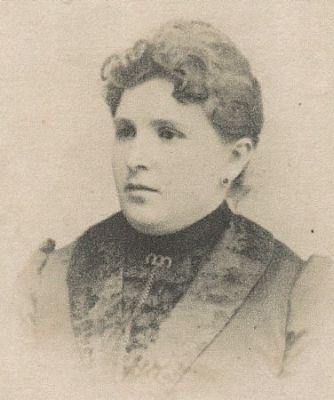
Rachel Kaplan (Sohn) (1863-1901) 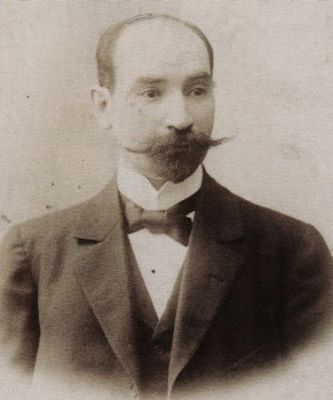
Susman Kaplan (1853-1919) Markus-David Kaplan was born on March 6th, 1899 in Tartu, Estonia. In those days Estonia was a part of the Russian empire and Tartu was called Yuriev. His father Susman Kaplan was a merchant. He came to Tartu from Lithuania before 1878 as we know that in 1878 he opened a clothing store at Aleksandri str. 5. David's mother - Rachel Kaplan (nee Sohn) was also from Lithuania. Markus-David was the fourth child in the family. The oldest - Josef was born in Tartu in 1884. He was followed by Masha in 1886 and by Nikolai in 1898 (two children, born in between, died in infancy). The daughter Anna (Anchen) (born in 1901) was the youngest.
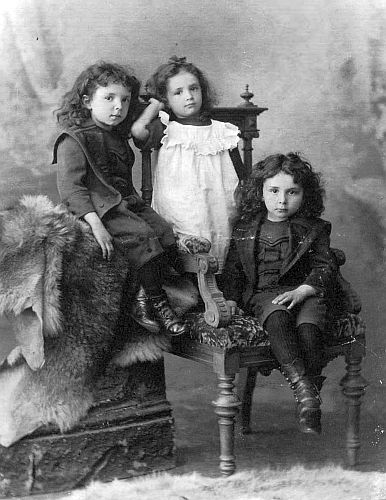
Nikolai (left), Anchen and David Kaplan (~1903) While German was the language spoken in the Kaplans’ home schooling was to be pursued in Russian, and in 1907 young David was sent to Tzar Aleksander Gymnasium, where he graduated in 1917. His grades were "satisfactory" with three exceptions - "good" in philosophy and geography and "excellent" in mathematical geography (same as astronomical geography - positioning of stars and planets). Isn't his later interest in moving objects and their interaction with light already from those days? Despite the ongoing WWI, the future looked bright. David was extremely talented. He took cello lessons and eventually became very proficient, he had interest in natural sciences and was a talented painter. You can enjoy the virtual exhibition of some of his paintings here /Culture/Kirsanoffp.html. The Kaplans were a musical family. David and his older brother Nikolai studied violin and cello at the Tartu music school. The brothers, who were very close their entire life, enjoyed making music together. As he recollects his first movie experience it seems obvious that this early encounter kindled more than a predictable flash of excitement in young David. This is how he puts it in an article published in the cinema magazine Cine-Cinea, in 1926 (“Les Problemes de la photogenie"): "I remember very well the impression that I have kept from my first visit to the cinema. This took place quite a while ago, at a time when cinema was still in its infancy, and it happened in a provincial town, one place where slowness is the norm; as a result most of the time I could see the movies in sort of slowed down mode, which reminds me in some ways of the modern slow motion. Well, at that time what impressed me most was this slow, non-realistic way of moving displayed by the actors. As a matter of course, I attributed the special quality of their movement to their acting skills, and at the cost of great pains and efforts I tried to but only failed to achieve what could not be achieved: imitate the non-imitable cinema movement...". David was also a keen reader, as was his close brother Nikolai, but whereas Nikolai's special love of French made him favour the French novelists, specially Guy de Maupassant, David had a deep affinity with the Russian language and literature, and loved immersing himself in Turgenev, Dostoevsky and Tolstoy - which may account for choosing Kirsanov (from Turgenev’s "Fathers and Sons") as his artistic patronymic. Francine Ryan remembers: "I also know that one of his dearest cinema projects and most fervent hope was to bring to the screen Dostoevsky’s novel "Crime and Punishment" - he had written a scenario, which I believe set the action in modern times. I remember coming across a single handwritten page from it where I spotted the name Sonia. Although I was only a little girl at the time I knew about the novel and its characters and finding that single page impressed me deeply, I am not quite sure why… suspecting a treasure, maybe? - Dimitri’s film of the novel would have been one, of this I am sure…". 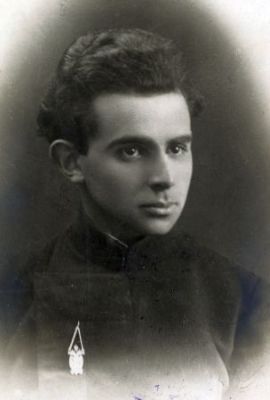
Markus-David Kaplan's gymnasium graduation picture (1917) 
Standing shoulder to shoulder, young David and close brother Nikolai - Yuriev-Tartu, ~1918.
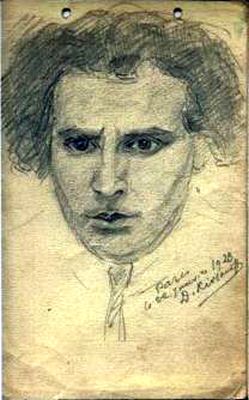
Dimitri Kirsanoff - autoportrait. Paris, 1923. 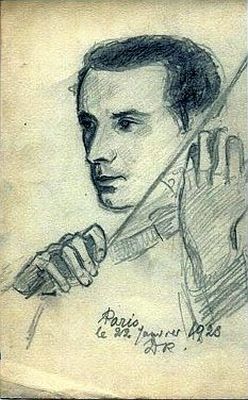
Portrait of brother Nikolai, painted shortly after Nikolai's arrival in Paris. 1923. But back to old days... In August 1917 David submitted his application to the Natural sciences department of the Physics and Mathematics faculty of the Tartu university and was accepted as a student. He intended to study chemistry. However, by May 1918 he had withdrawn his application, a move which may have been influenced by his music teacher’s suggestion of pushing forward with his cello studies. Anyway he decided to leave his native country and to continue his cello studies in one of the most prestigious European schools of music, the Conservatoire de Musique in Paris. He would have to live on a small monthly allowance sent by his elder brother Josef, a practicing GP back home. But the path of life has its own twists and turns and David only reached Paris in 1921. We don’t know the exact date of his departure and whether he was still in the country when his father Sussman was taken hostage and murdered by the Bolsheviks in January 1919. At any rate it was his brother Nikolai who was called to identify the body of his father, after the flight of the murderous gang… (more about the red terror in Tartu in 1919 here /history/terror_en.html). Francine Kaplan remembers how during a holiday in Brittany, invited by her dear uncle Dimitri and his wife Monique, he told her the marvelous story of his perilous journey through northern Europe in the last weeks of 1918, through countries whose regimes were collapsing under the combined onslaught of the Great War in its last throes and the convulsions of their own national revolutions.
She came across a photograph taken in August 1918 showing a group of playful youngsters posing in a woodland setting. The back of the postcard carries
friendly messages in Russian, one of those: “don’t forget your friends in the Ukraine.”
Ukraine in 1918 was torn between various powers and countries. Jewish pogroms had started already in 1917. There is similar uncertainty about his activity in Paris in the early days of his arrival there. Whether he pursued chemistry at the Ecole de chimie (in Swiss musicologist Jürg Stenzl’s book "Dmitrij Kirsanov”) or music at the Conservatoire (most other sources) he had only slender means to rely on for his day-to-day subsistence in the bustling capital. The money he got from Josef was not enough…
It was love at first sight. He didn’t forsake music and his cello would always be at hand. However his passion for the 7th Art was to be his driving force henceforth. He would be a film maker, and his own master at that. His career took off in the Paris of the early twenties; a time when the French capital was a vibrant center of artistic adventurousness. However his unbending claim for artistic independence led him away from any type of affiliation, ethnic or artistic; his only partner in work as in life was Nadia Sibirskaia (Breton born Germaine Lebas (1901-1980)), the inspiring and inspired female performer in his early films. We will now only call him as Dimitri Kirsanoff. This is the name on his paintings, this is the name by which he entered the world of movies. His first film L'Ironie du destin (Irony of fate) - (1921/22) is no longer available. It was a silent movie as all of his first films, and the actors were Nadia Sibirskaia and Dimitri Kirsanoff. His second and most famous film, Ménilmontant (1924-1926) earned him praise from artistic circles, as a precursor of “poetic realism”.
"Ménilmontant is the one impressionistic film that can definitely be labelled a timeless masterpiece". (filmsdefrance.com 2015). The plot: The peace of a rural community is shattered when a man and his wife are violently attacked and murdered with an axe by a deranged killer. At the time, the couple's two daughters are blissfully unaware of their parents' fate - they are occupied trying to recover a cat that has climbed up a tree. Some years later, the sisters try to make a new life for themselves, working in a factory making artificial flowers in a busy working class district of Paris, Ménilmontant. One day, the younger sister meets a handsome young Lothario, who wastes no time seducing her. By the time she realises she is pregnant, the young woman has been abandoned by her lover and she is shocked to learn that he has begun an affair with her sister... (filmsdefrance.com 2015). The film takes its title from the working-class district of Paris where its drama occurs. Unusual for that time, there are no titles in this silent film, so the plot is communicated entirely with imagery. Many of the scenes are filmed with a hand-held camera. Further indepth discussions of the outstanding and innovative aspects of this film, can be found on various Internet sites. 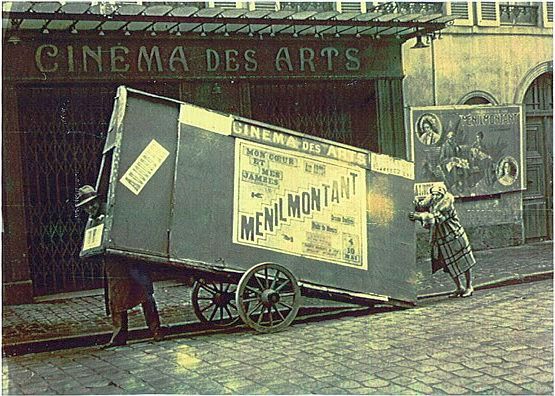
First release of Ménilmontant, May 1924 Cinema des Arts - Paris. Dimitri and Nadia combine their strength to ‘advertise’ their work! This film was followed by "Destin" (1928) and "Sables" (1928). The official screening of his next film "Brumes d'automne" (Autumn mists) took place in December 1928.
"This is the most perfect and most eloquent of all the films made by Dimitri Kirsanoff". (filmsdefrance.com 2015) The plot: As autumn cloaks the world with her habitual melancholia, as mists descend and leaves fall from the trees onto sodden ground, a woman reflects on her past beside an open fire. Tearfully, she throws old letters onto the flames as memories tinged with sorrow and bitterness flicker across her mind. She leaves the sanctuary of her home and ventures outside, to find a comforting communion with the mournful solemnity of autumn... (filmsdefrance.com 2015) "Impressions Africaines" (1929), "Le Croisé" (unfinished) and "Les Nuits de Port-Said" (1931) were the next films. They were followed by "Rapt" (Kidnapping) in 1934. The film is based on a novel "La Séparation des races" by Swiss novelist Charles Ferdinand Ramuz.
"Rapt (The Kidnapping) is a romantic tragedy made eloquent not only by a dynamic use of montage but also a moody, aptly jangling score by Arthur Honegger and Arthur Hoeree that still sounds excitingly avant-garde". For the first time in film-making music was considered foundational. The plot: The people who live on two sides of a mountain are divided by language, religion and custom. On the French side, the shepherd Firmin discovers that his dog has been killed by Hans, a man on the German side. He takes his revenge by kidnapping the latter's fiancée Elsi and holding her prisoner in his house, despite his mother's reproaches. Elsi promises her captor that she will be his bride if he will live with her on the other side of the mountain... (filmsdefrance.com 2015). Before the Second World War Kirsanoff made 9 more films. The war broke the course of his career; and endangered his life as a Jew. He took refuge in the still unoccupied South of France with his second wife Monique Kirsanoff (Berthe Noëlle Bessette). For a while they shared the exile of his brother Nicolas and his family in Albi in the Tarn region, where they had taken refuge away from the combined threats of the Nazi and Vichy administrations, during the dark days of the Occupation, from 1939 to 1945. Francine Ryan-Kaplan remembers: "After the war Dimitri and Monique Kirsanoff’s first visit to us dates back to 1946 and there are these three truly magnificent paintings to document it. [See /Culture/Kirsanoffp.html]: Nicolas reading the paper in the dining room of our modest rented dwelling in Carmaux, 14 Place Gambetta. Myself also reading, in that same setting. And the wonderfully lively image of life back to normal: Market day on Place Gambetta, under our windows, with those three boys isolated from the crowd, who are my brothers Serge and Jean Jacques and whoever was their pal, standing alone from the crowd… Yes! life had prevailed - the two Kaplan brothers could meet again... Dimitri painted those wonderful testimonies to the triumph of life, on bad ‘contreplaqué’, with whatever paint was available at the time". 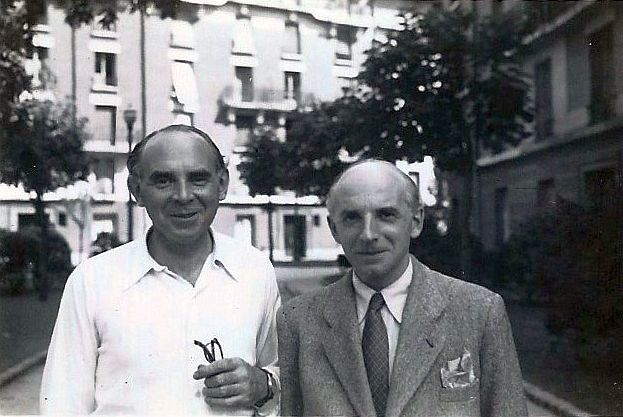
Dimitri Kirsanoff (left) with his beloved brother and friend Nikolas Kaplan. Carmaux, July 1947. "After the war Dimitri Kirsanoff would find his professional path as a film author strewn with difficulties of all kinds. He was the same demanding artist of exceptional rich and intense sensitivity; his were still the same creative drive and courage to serve his vision and the fierce independence to defend it; as such he was not given access to the commercial field where cinema was now conducting its business. In personal relationships he had lost none of his truly irradiating gift of sympathy, still coupled with the same exacting sense of honesty and integrity". (Francine Ryan-Kaplan). "One would think that with the release of such a film [Rapt] a rich career would have been opened to its creator. On the contrary, in the twenty-four years between Rapt and his death early this year [1957], Kirsanov never again had the opportunity of directing a major film with any appreciable freedom. Thus has the cinema, stepchild of the arts, treated its masters ever since Greed [by Erich von Stroheim]". (Walter S. Michel). "In these conversations, Mlle Eisner and I were the ones to be upset by the extent of his neglect. He himself was clearly no longer concerned — if he ever had been — with questions of recognition. All his thinking and energy seemed directed only toward the one end: creation. I think he would have gone anywhere on earth to make a film". (Walter S. Michel). After the war, amidst his unremitting, unrewarding efforts to win or regain the confidence of producers and secure even modest financial backing from them, Dimitri Kirsanoff managed to craft a few ‘gems’ - one of them is an adaptation of a short story by the famous French novel and short story writer Guy de Maupassant - elder brother Nikolai’s favourite French author - This short masterpiece is named after the story it ‘narrates’ in cinematic terms: Deux Amis (Two friends). "Deux Amis". Here with introduction about D. Kirsanoff (in French). Dimitri Kirsanoff died from a heart attack in Paris on February 11th, 1957. "A great artist and man is gone. Almost unknown in this country and forgotten in Europe, Dimitri Kirsanov was a poet who chose the cinema as his medium of expression and gave us, with Ménilmontant, Brumes d’automne and Rapt, three of the most beautiful and intelligent films in the history of the cinema. He is neglected, partly because his films are poetry and do not fit the usual categories, partly because only one of them is easily accessible". (Walter S. Michel, 1957). Two more Kirsanoff's films available on YouTube: |